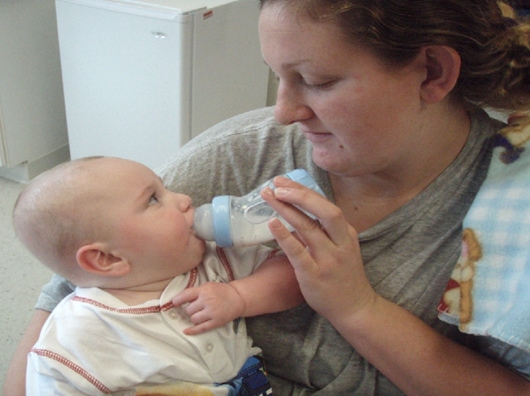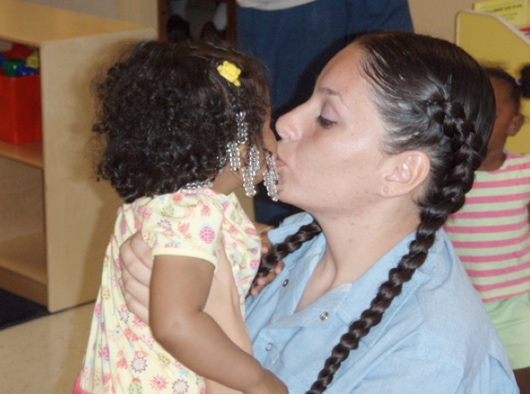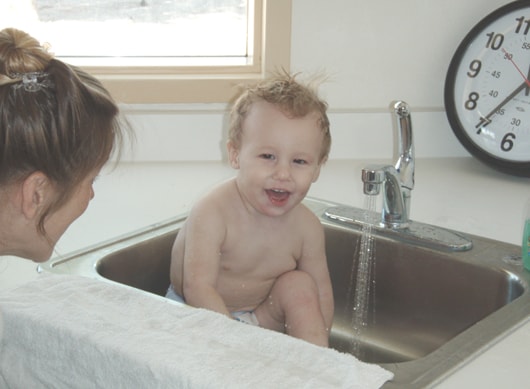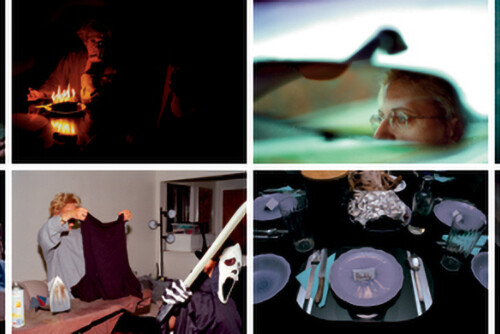Putting Research and Developmental Concepts into Practice
A developmental perspective recognizes that child development normally occurs and is most successful within a nest of healthy human relationships. It leads to the conclusion that services intended to improve children’s outcomes will improve the quality of children’s care and relationships, and so should be focused on parents/caregivers or the parent/caregiver-child relationship, rather than on children alone.


Relationship-based practice is an approach to service delivery that encompasses these characteristics. 1 Pawl, quoted in Copa, Lucinski, Olsen, and Wollenburg (1999), defined relationship-based practice as “doing onto others as you would have others do onto others”. 2 With this approach, the practitioner provides for the parent/caregiver what she wants the parent/caregiver to provide for the child, i.e. a responsive, nurturing relationship. This approach is particularly useful for parents whose own attachment experiences and early care were not optimal and whose individual needs are unmet.
Estranged from her family and cut off from Bella’s father during pregnancy, Natalia suffered from serious postpartum depression. At their first ChildSpace visit, Natalia was stiff and awkward, carrying 2-month-old Bella out in front of her like an object. After the visit, she cried, “I can’t do this, I can’t be a mother!” and talked about asking her sister to adopt Bella. Concerned, Natalia’s MIRACLE Advocate increased the frequency and intensity of their sessions and encouraged more ChildSpace visits. Using her Advocate’s nurturing as a model, Natalia slowly became more responsive to Bella, began to enjoy their visits, and developed parental competence. This work took place over an extended period of time, as Natalia learned to trust others to be aware of and responsive to her needs.
A critical element of relationship-based practice is the quality of the practitioner. Practitioners who deliver relationship-based services must:
- Be capable of healthy relationships
- Have a stable sense of identity
- Have an appropriate motivation for the work
- Understand that who they are will affect the work that they do
- Have the ability to manage the effects of the work on themselves as individuals and as practitioners
These requirements demand an increased investment in the recruitment, screening and training of practitioners. But this investment is worthwhile because the relationship-based approach significantly increases the effectiveness of parent, child and family services. 3
For the past 20 years, the Center has used relationship-based practice in services for criminal offenders and their children.
How It Works
The Center’s recent efforts in correctional mother-child reunification programs illustrate how the Center brings together client characteristics, developmental concepts, and relationship-based practice to deliver effective services for children of incarcerated parents.
Service Design
The Center has implemented the following major service projects in one or more correctional facilities:
- The MIRACLE Project serves pregnant and postpartum prisoners, offering: 1) prenatal risk assessment; 2) weekly, home-based prenatal and infant development education sessions focused on establishing healthy maternal-infant bonds; 3) intensive case management, including work with infants’ caregivers; and 4) a minimum of 5 years of home-based services in the community following the mother’s release. Each participating mother is assigned a Family Advocate who is part of a team of practitioners supervised by an expert in relationship-based practice. MIRACLE has been offered in Southern California jails and prisons since 2001 and has served more than 600 mothers and their families.


- The Mothers’ Institute offers imprisoned mothers 20 hours of activities each week in three 6-month cycles. Services include: 1) psychoeducational parent education and family life education classes; 2) prenatal, infant and child development classes; 3) classes in family resource management; 4) mothers’ support groups; 5) reproductive issues groups; 6) family reunification activity groups; 7) “alternative therapies” including yoga, sensorimotor interventions, meditation and mindfulness activities; and 8) transitional groups for mothers preparing to be released. Over 200 mothers have participated in the Institute since 2006.

- The ChildSpace Project offers intensive mother-child visitation in a specially-designed, developmentally-appropriate environment. This project includes extended-contact visitation for mothers and children from birth to 15 years of age; mediated visitation, facilitated by a developmental psychologist, for mothers and their children 13-17 years of age; and support services for families and caregivers of visiting children. ChildSpace was offered beginning in 2006 and has served more than 1200 children.


In each of these projects, services are focused on enhancing the responsiveness of mothers to their children. Major efforts are exerted to secure post-release placements for families in structured settings, like residential drug treatment programs, that will minimize family stress and support the mother-child bond. As in all of the Center’s intensive services, the staff in each of these core projects focus on developing healthy, appropriate relationships with participating mothers, with the goal of serving as supplemental attachment figures in their lives.
While the Center emphasizes relationships in service delivery, project operations are also important in increasing the effectiveness of services. Operations in the Center’s intensive service projects are characterized by features identified by Sambrano, Janson and O’Neill (1998) as hallmarks of effective services for high-risk populations, including: 1) high intensity, with a minimum of 3 hours of participant-staff contact per week; 2) a relational or connection-building focus of activities; 3) an emphasis in all activities on behavioral change; and 4) coherent implementation and execution of services. 4
After having visits with the twins twice a week for 5 months, Dominique was abruptly transferred to a temporary work assignment where she could not participate in ChildSpace. Project staff objected that the change would be detrimental to the infants. “I don’t see the problem,” the correctional supervisor responded. “They’ve been having visits and it’s not like she is being permanently reassigned. Aren’t some services better than no services at all?”
The most challenging operational issue for Center staff in MIRACLE, the Mothers’ Institute, and ChildSpace Projects was achieving coherency and consistency of services for children in correctional settings.
Participants
These three core projects have served more than 1400 families. Participating mothers had an average of 2.6 minor children each. The children had a mean age of 5.0 years and approximately half were biracial or multiracial. A slight majority had been living with their mothers immediately prior to maternal incarceration. Most were in the current care of their maternal grandmothers or birth fathers. About one in five children were under the supervision of the foster care system.
The mean age of participating mothers was 27 years for all projects. Participants were generally representative of the larger correctional population of their facilities in race/ethnicity, with somewhat lower proportions of Black and White mothers and higher proportions of Latina and Native American mothers in the Mothers’ Institute and ChildSpace. The majority of participants had served previous incarceration sentences. Mothers from all custody classification levels were accepted for participation and participants’ criminal justice profiles—including offense histories, instant offenses, sentences and time served—reflected the profiles of all prisoners in a given institution.
Staffing
Staffing is perhaps the most critical element of the Center’s intensive services. Preference in hiring is given to qualified practitioners who are formerly incarcerated parents and/or the adult children of current or former prisoners. Staff in all projects is reflective of the Center’s service population in race/ethnicity. The Center’s staff usually includes about 40% former prisoners, about 20% adult children of current or former prisoners, and about 20% who are both children of prisoners and formerly incarcerated.
Alyssa’s first ChildSpace session with her daughters was stressful because they had not seen each other for more than a year. Their conversation started, stuttered, and stopped again and again. During snack time, a ChildSpace worker talked with the girls about her own experience visiting her father in prison as a child, while the Coordinator talked with Alyssa about how he felt receiving a child’s visit while incarcerated. After snack, Alyssa and the girls had visibly relaxed and were comfortable resuming the visit.
Most Center practitioners have credentials in child development or behavioral science. The Center requires practitioners to have a minimum of two years of prior experience working with parent-child correctional populations. This approach reduces training and orientation time, increases staff retention and improves the ability of practitioners to recognize and meet clients’ needs. Between 2006 and 2009, staff in MIRACLE, Mother’s Institute, and ChildSpace Projects had an average of 12 years of experience serving mother-child correctional populations.
All Center staff participate in a minimum 48 hours of training before providing services and receive a minimum of 4 hours of training per month while providing services. All staff also take part in weekly group supervision and biweekly individual supervision. As a relationship-based practice agency, the Center utilizes reflective supervision to help practitioners establish and maintain clarity of purpose in their work, recognize and address the ways in which their personal characteristics and behaviors affect the services they deliver, and recognize and address the ways in which the work is affecting them. 5
- R. Parlakian, Look, Listen, And Learn: Reflective Supervision And Relationship-Based Work (Washington, DC: Zero to Three, 2001).[↑]
- A. Copa, L. Lucinski, E. Olsen, and K. Wollenburg, Promoting Professional and Organizational Development: A Reflective Practice Model (Washington, DC: Zero to Three, 1999).[↑]
- A. Copa, et al.[↑]
- S. Sambrano, M.A. Jansen, and S.J. O’Neill, “Emerging Findings from High-Risk Youth Prevention Programs,” Journal of Community Psychology 25.5 (1998): 371-373.[↑]
- E. Fenichel, Learning Through Supervision and Mentorship to Support the Development of Infants, Toddlers, and Their Families: A Sourcebook (Washington, D.C.: Zero to Three, 1992); R. Parlakian (2001).[↑]



